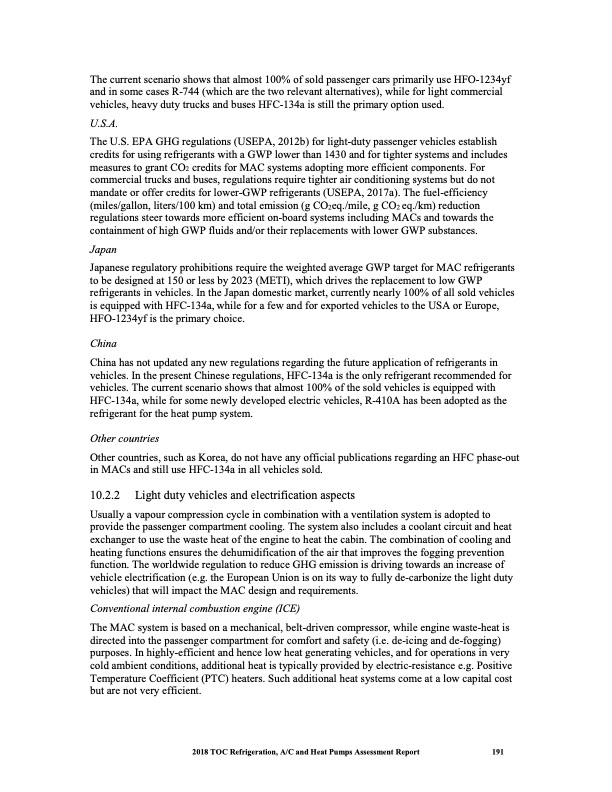
PDF Publication Title:
Text from PDF Page: 204
The current scenario shows that almost 100% of sold passenger cars primarily use HFO-1234yf and in some cases R-744 (which are the two relevant alternatives), while for light commercial vehicles, heavy duty trucks and buses HFC-134a is still the primary option used. U.S.A. The U.S. EPA GHG regulations (USEPA, 2012b) for light-duty passenger vehicles establish credits for using refrigerants with a GWP lower than 1430 and for tighter systems and includes measures to grant CO2 credits for MAC systems adopting more efficient components. For commercial trucks and buses, regulations require tighter air conditioning systems but do not mandate or offer credits for lower-GWP refrigerants (USEPA, 2017a). The fuel-efficiency (miles/gallon, liters/100 km) and total emission (g CO2eq./mile, g CO2 eq./km) reduction regulations steer towards more efficient on-board systems including MACs and towards the containment of high GWP fluids and/or their replacements with lower GWP substances. Japan Japanese regulatory prohibitions require the weighted average GWP target for MAC refrigerants to be designed at 150 or less by 2023 (METI), which drives the replacement to low GWP refrigerants in vehicles. In the Japan domestic market, currently nearly 100% of all sold vehicles is equipped with HFC-134a, while for a few and for exported vehicles to the USA or Europe, HFO-1234yf is the primary choice. China China has not updated any new regulations regarding the future application of refrigerants in vehicles. In the present Chinese regulations, HFC-134a is the only refrigerant recommended for vehicles. The current scenario shows that almost 100% of the sold vehicles is equipped with HFC-134a, while for some newly developed electric vehicles, R-410A has been adopted as the refrigerant for the heat pump system. Other countries Other countries, such as Korea, do not have any official publications regarding an HFC phase-out in MACs and still use HFC-134a in all vehicles sold. 10.2.2 Light duty vehicles and electrification aspects Usually a vapour compression cycle in combination with a ventilation system is adopted to provide the passenger compartment cooling. The system also includes a coolant circuit and heat exchanger to use the waste heat of the engine to heat the cabin. The combination of cooling and heating functions ensures the dehumidification of the air that improves the fogging prevention function. The worldwide regulation to reduce GHG emission is driving towards an increase of vehicle electrification (e.g. the European Union is on its way to fully de-carbonize the light duty vehicles) that will impact the MAC design and requirements. Conventional internal combustion engine (ICE) The MAC system is based on a mechanical, belt-driven compressor, while engine waste-heat is directed into the passenger compartment for comfort and safety (i.e. de-icing and de-fogging) purposes. In highly-efficient and hence low heat generating vehicles, and for operations in very cold ambient conditions, additional heat is typically provided by electric-resistance e.g. Positive Temperature Coefficient (PTC) heaters. Such additional heat systems come at a low capital cost but are not very efficient. 2018 TOC Refrigeration, A/C and Heat Pumps Assessment Report 191PDF Image | Heat Pumps Technical Options

PDF Search Title:
Heat Pumps Technical OptionsOriginal File Name Searched:
RTOC-assessment-report-2018_0.pdfDIY PDF Search: Google It | Yahoo | Bing
CO2 Organic Rankine Cycle Experimenter Platform The supercritical CO2 phase change system is both a heat pump and organic rankine cycle which can be used for those purposes and as a supercritical extractor for advanced subcritical and supercritical extraction technology. Uses include producing nanoparticles, precious metal CO2 extraction, lithium battery recycling, and other applications... More Info
Heat Pumps CO2 ORC Heat Pump System Platform More Info
| CONTACT TEL: 608-238-6001 Email: greg@infinityturbine.com | RSS | AMP |